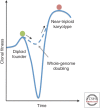Chromosomal Instability as a Driver of Tumor Heterogeneity and Evolution
- PMID: 28213433
- PMCID: PMC5453382
- DOI: 10.1101/cshperspect.a029611
Chromosomal Instability as a Driver of Tumor Heterogeneity and Evolution
Abstract
Large-scale, massively parallel sequencing of human cancer samples has revealed tremendous genetic heterogeneity within individual tumors. Indeed, tumors are composed of an admixture of diverse subpopulations-subclones-that vary in space and time. Here, we discuss a principal driver of clonal diversification in cancer known as chromosomal instability (CIN), which complements other modes of genetic diversification creating the multilayered genomic instability often seen in human cancer. Cancer cells have evolved to fine-tune chromosome missegregation rates to balance the acquisition of heterogeneity while preserving favorable genotypes, a dependence that can be exploited for a therapeutic benefit. We discuss how whole-genome doubling events accelerate clonal evolution in a subset of tumors by providing a viable path toward favorable near-triploid karyotypes and present evidence for CIN-induced clonal speciation that can overcome the dependence on truncal initiating events.
Copyright © 2017 Cold Spring Harbor Laboratory Press; all rights reserved.
Figures




References
-
- Ame JC, Cimini D, Fouquerel E, Gauthier LR, Biard D, Boussin FD, Dantzer F, de Murcia G, Schreiber V. 2008. Merotelic kinetochore orientation, aneuploidy, and cancer. Biochim Biophys Acta 1786: 32–40. - PubMed
Publication types
MeSH terms
LinkOut - more resources
Full Text Sources
Other Literature Sources
